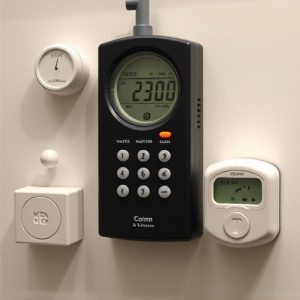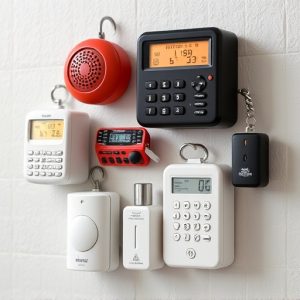Wearable Security Devices: Rechargeable vs Battery Power for Personal Safety
Wearable security devices, popular for personal safety, come in rechargeable or battery-powered vari…….
Wearable security devices, popular for personal safety, come in rechargeable or battery-powered varieties. Rechargeables offer environmental benefits and cost savings but require charging; batteries provide instant protection but need frequent replacement. Both types include mobile alerts and GPS tracking via smartphone apps. When choosing, consider readiness (batteries) vs. sustainability (rechargeable), desired features like siren intensity and activity tracking, compatibility with your phone, water resistance, and comfort. Rechargeables are a game-changer for eco-conscious users who prioritize long-term cost savings over instant protection.
In an era where personal safety is paramount, wearable security devices equipped with mobile alerts have emerged as powerful tools. This article explores the rising trend of these innovative gadgets, delving into their capabilities and benefits. We dissect the crucial role of mobile alerts in enhancing personal safety and compare rechargeable vs battery-powered personal alarms, highlighting key advantages. Additionally, we guide readers through essential factors to consider while choosing a wearable alarm device, offering real-world applications and success stories to illustrate their effectiveness.
- Understanding Wearable Security Devices: A Growing Trend
- The Role of Mobile Alerts in Personal Safety
- Rechargeable vs Battery-Powered Personal Alarms: Comparison and Benefits
- Factors to Consider When Choosing a Wearable Alarm Device
- Real-World Applications and Success Stories
Understanding Wearable Security Devices: A Growing Trend
Wearable security devices have emerged as a popular choice for personal safety, offering a new level of protection in today’s digital age. These innovative gadgets come in various forms, from sleek smart watches to compact and versatile keychains, all designed with one primary function: to provide users with peace of mind and the ability to deter potential threats. The market is witnessing a rapid growth in this sector as folks seek convenient ways to stay safe while on-the-go.
One significant aspect that sets these devices apart is the option between rechargeable and battery-powered personal alarms. Rechargeable models are becoming increasingly popular due to their eco-friendly nature and cost-effectiveness over time. On the other hand, traditional battery-powered alarms offer instant readiness and peace of mind, ensuring users have a backup solution when needed. With advanced features like mobile alerts and GPS tracking, these wearable devices provide users with real-time data and control, allowing them to stay connected and informed about their surroundings.
The Role of Mobile Alerts in Personal Safety
Mobile alerts play a pivotal role in enhancing personal safety, especially with wearable security devices. These alerts provide users with a sense of security and control over their well-being. When integrated with wearable alarms, mobile notifications can instantly inform individuals about potential dangers or emergencies, allowing them to take prompt actions for self-protection. For instance, a rechargeable personal alarm that connects to one’s smartphone can send automated alerts to pre-selected contacts during an emergency, ensuring quick response times and access to assistance.
Unlike traditional battery-powered alarms that may require frequent replacement, rechargeable devices offer a more sustainable and cost-effective solution. Mobile connectivity further adds to their convenience by enabling users to manage settings, customize alert types, and monitor device status through their smartphones. This integration of technology not only enhances personal safety but also provides peace of mind, knowing that help is just a notification away.
Rechargeable vs Battery-Powered Personal Alarms: Comparison and Benefits
When it comes to wearable security devices with mobile alerts, the choice between rechargeable and battery-powered personal alarms is an important one. Rechargeable models offer several advantages, most notably their environmental friendliness and cost-effectiveness in the long run. These devices can be plugged into any standard power outlet for recharging, eliminating the need for frequent replacement of disposable batteries. This not only reduces waste but also saves users from the hassle and expense of constantly buying new batteries.
On the other hand, battery-powered personal alarms provide immediate convenience and reliability. They are ready to use out of the box, without any charging time required. While this option may be more expensive upfront due to frequent battery replacements, it ensures a consistent power supply in situations where recharging might not be readily available or practical, making it a preferred choice for those who prioritize readiness over long-term savings.
Factors to Consider When Choosing a Wearable Alarm Device
When selecting a wearable security device with mobile alerts, there are several factors to keep in mind. One of the key considerations is power source: opt for a rechargeable model over one that relies solely on batteries. Rechargeable devices not only reduce costs but also ensure you’re never caught off guard by a dead battery. Additionally, consider the type of personal alarm the device offers. Some models feature loud sirens, while others incorporate GPS tracking and automatic alert systems upon detecting falls or unusual activity.
Furthermore, check for compatibility with your smartphone and operating system. Seamless integration ensures you can quickly access alerts and control settings on your mobile device. Durability is another important aspect; look for water-resistant or waterproof designs if you plan to wear the device during workouts or outdoor activities. Lastly, assess the comfort level of the wearable design, as a snug and adjustable fit will ensure it stays in place when you need it most.
Real-World Applications and Success Stories
Wearable security devices with mobile alerts have found real-world applications, transforming personal safety and peace of mind. These innovative tools offer a range of features, from simple personal alarms to complex tracking systems, all accessible through a smartphone app. One of the key advantages lies in their portability; individuals can carry these devices discreetly, providing an extra layer of protection whether at home or on-the-go.
Success stories abound, highlighting the effectiveness of wearable security. For instance, many users rely on rechargeable personal alarms as a quick and convenient way to deter potential threats. These devices often incorporate long-lasting batteries or solar charging options, ensuring they’re always ready for use. Unlike traditional battery-powered personal alarms that may require frequent replacement, rechargeable models offer a more sustainable solution, contributing to reduced waste.
Wearable security devices with mobile alerts are revolutionizing personal safety, offering both peace of mind and empowering individuals to take control. By comparing rechargeable vs battery-powered personal alarms, users can make informed decisions based on their needs and lifestyle. Understanding the factors that influence choice ensures the selection of a reliable device, as showcased by real-world applications and success stories. Whether for outdoor adventures or everyday carry, these innovative tools provide an extra layer of protection in today’s digital era.


